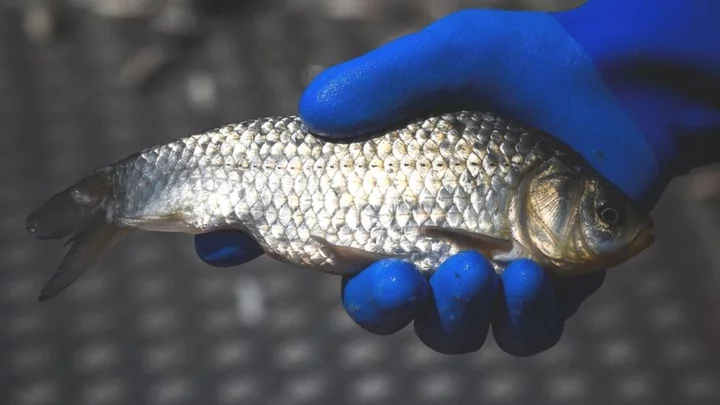
Common foot problems faced by runners – and how to solve them
Whether you’re taking on a marathon or running a 5k parkrun, your feet will make or break a run and a problem could put you off the activity for good. “Runners’ feet take a real battering, as you will know if you have recently run a marathon or even if you are new to running,” says GP Dr Gill Jenkins, an adviser to Excilor. “Feet bashing on hard ground, sweaty socks and shoes can all play havoc with your feet.” So, what problems could you face and how can you stop them hindering your progress? Blisters “Hot and sweaty feet usually mean blisters. As you start to run, your feet sweat, and the moisture in your shoes can cause friction, leading to blisters, says Joss Baldwin, Runners Need buyer. “Investing in a pair of running shoes made from breathable fabrics, with mesh vents on the uppers, boost airflow and allow any moisture to escape your shoes – reducing your risk of blisters,” “It’s also important to ensure your running shoes fit properly – shoes that are too tight or too loose increase the chance of rubbing and friction, only adding to the likelihood of blisters occurring.” Many trainer brands and sports shops such as Runners Need and ASICS offer gait analysis to help you choose the best-fitting shoes. “While breathable trainers are vital, wearing the appropriate socks will reduce your risk of soreness and rubbing. Invest in a good pair of technical run socks to keep your feet cool and wick the moisture away from your skin. Features to look out for are technical and sweat-wicking fabrics, mesh ventilation under the arch, as well as a snug fit,” says Baldwin. Athlete’s foot “Athlete’s foot is a fungal infection that occurs between the toes but can spread to the top and bottom of the foot if not treated. It can be very itchy and sore if the skin breaks, plus it spreads quickly in damp environments including running shoes but also changing rooms,” says Jenkins. It should not be ignored, and there are plenty of quick and easy treatments available in pharmacies. Ankle pain “When you’re first getting into running, foot problems can be common, but the good news is they are mostly avoidable,” says Baldwin. “Sometimes it is simply a case of getting your body used to the new activity, but all the time we see new runners in shoes that aren’t right for them. Overpronation, where your foot rolls in excessively, poor fitting and worn-out cushioning can cause a myriad aches and pains in your body. All are really easy to correct by getting a proper shoe fit and gait analysis.” There are different shoes for different activities that can protect your ankles and feet. “Everyone’s feet are different and that means everyone’s running shoe requirements are unique. Choosing the right shoe for your run can help avoid ankle pain,” says Baldwin. “If most of your training is on pavements, then road shoes are for you. With more cushioning than trail or lightweight race shoes, these will provide shock absorption to minimise your risk of injury. If you’re running through soft, muddy trails, you’re better off in a pair of trail shoes with a deep tread that offers better grip and ankle support, vital for running on uneven terrain. On pavements, however, these shoes will be uncomfortable as the studs will press into the soles of your feet and will wear away quickly.” He adds: “If you’re doing a little of each, you should consider a hybrid running shoe. These shoes work well on both roads and mixed trail conditions with a balanced mix of grip and cushioning.” Toenail problems “Toenail problems are commonly caused by a fungal infection and research for Excilor showed 49% of sufferers not aware they had a fungal nail infection,” says Jenkins. “Infections are incredibly common, especially with runners, and are also highly contagious, thriving on damp feet. Symptoms include discoloured nails and itchy and painful feet. Treat nail infections immediately as they can worsen rapidly.” Similarly, running long distances may damage the toenail itself. “The longer we run the warmer our feet get,” says Baldwin. “As they get warmer, they actually start to swell and become bigger. It is really important to take this into account when selecting your shoes. Typically we need to size our running shoes bigger than our normal shoes to stop our toes hitting the end of the shoe, which can cause our toes – and toenails – to become sore or bruised.” Read More Charity boss speaks out over ‘traumatic’ encounter with royal aide Ukraine war’s heaviest fight rages in east - follow live Paparazzi driver says Harry and Meghan chase was ‘catastrophic experience’ Regular exercise may lower risk of women developing Parkinson’s disease – study Number of children trying vaping rises 50% in a year
2023-05-19 15:50

Blur announce new album
Blur are to release 'The Ballad of Darren', their first album in eight years, on 21 July.
2023-05-19 15:27

Abortion: Pressure grows on Virginia as new bans arise in the south
Virginia could become the only southern state to allow abortions after 12 weeks of pregnancy.
2023-05-19 07:51

Portugal media guide
An overview of the media in Portugal, including links to broadcasters and newspapers.
2023-05-18 23:45

Spain media guide
An overview of the media in Spain, including links to broadcasters and newspapers.
2023-05-18 23:21

Regular exercise may lower risk of women developing Parkinson’s disease – study
Getting regular exercise such as cycling, walking, gardening, cleaning and participating in sports may decrease the risk of developing Parkinson’s disease in women, a study suggests. Women who exercised the most had a 25% lower rate of the condition when compared to those who exercised the least. The research also found that 10 years before diagnosis, levels of exercise fell at a faster rate in those with Parkinson’s than in those without, likely due to early symptoms of the disease. Experts suggest the findings support the creation of exercise programmes to help lower the risk of Parkinson’s. Our results support the creation of exercise programmes to help lower the risk of Parkinson’s disease Dr Alexis Elbaz, Inserm research centre Study author Alexis Elbaz, of the Inserm research centre in Paris, France, said: “Exercise is a low-cost way to improve health overall, so our study sought to determine if it may be linked to a lower risk of developing Parkinson’s disease, a debilitating disease that has no cure. “Our results provide evidence for planning interventions to prevent Parkinson’s disease.” Dr Elbaz added: “With our large study, not only did we find that female participants who exercise the most have a lower rate of developing Parkinson’s disease, we also showed that early symptoms of Parkinson’s disease were unlikely to explain these findings, and instead that exercise is beneficial and may help delay or prevent this disease. “Our results support the creation of exercise programmes to help lower the risk of Parkinson’s disease.” The study included 95,354 female participants, mostly teachers, with an average age of 49 who did not have Parkinson’s disease at the start of the study. The women were followed for three decades during which 1,074 of them developed Parkinson’s, and over the course of the study asked to complete up to six questionnaires. They were asked how far they walked and how many flights of stairs they climbed daily, how many hours they spent on household activities as well as how much time they spent doing moderate recreational activities such as gardening and more vigorous activities such as sports. Researchers assigned each activity a score based on the metabolic equivalent of a task (METs), a way to quantify energy expenditure. For each activity, METs were multiplied by their frequency and duration in order to get a physical activity score of METs-hours per week. For example, a more intense form of exercise like cycling was six METs, while less intense exercise such as walking and cleaning was three METs. The average physical activity level for participants was 45 METs-hours per week at the start of the study. Women in the study were divided into four equal groups of just over 24,000 people each. At the start of the study, those in the highest group had an average physical activity score of 71 METs-hours per week, while those in the lowest had an average score of 27. In the group that did the most exercise, there were 246 cases of Parkinson’s disease, compared to 286 cases in the lowest exercise group. After adjusting for factors such as place of residence, age of first period and menopausal status, and smoking, researchers found those in the highest exercise group had a 25% lower rate of developing Parkinson’s disease than those in the lowest exercise group when physical activity was assessed up to 10 years before diagnosis. They found this association remained when physical activity was assessed up to 15 or 20 years before diagnosis. The results were similar after adjusting for diet or medical conditions such as high blood pressure, diabetes and cardiovascular disease, researchers found. The findings were published in the Neurology journal. Read More Charity boss speaks out over ‘traumatic’ encounter with royal aide Ukraine war’s heaviest fight rages in east - follow live Number of children trying vaping rises 50% in a year All of the star cars to look out for in the new Fast X film Spice Girl Geri Horner ‘so proud’ of King Charles as she gives him a hug and kiss
2023-05-18 19:59

Czech Republic media guide
An overview of the media in the Czech Republic, including links to broadcasters and newspapers.
2023-05-18 18:57

Foo Fighters dedicate new album to Taylor Hawkins and Dave Grohl's mom
Foo Fighters have shared the special dedication for the upcoming LP.
2023-05-18 17:28

Why going sober could be the key to fitness success
Despite having ambitious fitness goals, or a desire to create a change in our lives, many of us are reluctant to give up alcohol. Surely it cannot affect our fitness routines and progress that much, just to enjoy a glass of wine, or a few beers at the pub? But, as Drinkaware explains, alcohol has a negative impact on physical performance, motor skills and brain function. So, what could going sober allow us to achieve health and fitness-wise? “Since going sober two years ago, my training performance, energy levels and mental clarity have skyrocketed,” says personal trainer Josh Davies, from Aimee Victoria Long personal training. So, how does it impact your fitness? Poor sleep and hydration Alcohol has plenty of detrimental impacts on our bodies that hinder our fitness performance. “Firstly, alcohol causes dehydration. We all know the importance of being hydrated when it comes to bodily function,” says Davies. “Secondly, alcohol has a huge effect on the quality of your sleep. Alcohol prevents the body from getting into deep and REM sleep – the part of your sleep that helps with recovery and restoration. “If you’re not getting adequate amounts of this type of sleep, you won’t recover between sessions and are unable to perform when working out.”Motivation and emotions A terrible hangover or consistent fuzzy feeling is not the best if you want to get up and go when it comes to fitness, and the result-restriction caused by drinking could be holding you back. “If you’re not seeing progression in training and you’re feeling tired from the effects of alcohol, your motivation levels are likely to wane,” says Davies. Similarly, its mood-lowering effects can make you want to do anything but workout. “Whenever I used to drink too much, I used to wake up the next day and feel awful. It would leave me not being the best version of myself and stop me from pushing myself to my limits with fitness. I’d feel low, depressed and all I’d want to do is stay in bed,” says Lauren White, addiction coach and former PT. “Alcohol would always make me depressed, I would isolate and want to be alone. I was always into fitness at a young age and knew I was good at it, but when I started getting into drinking too much, I stopped looking after my body and forgot myself and my identity,” she explains. Aids with weight loss Weight loss is not, nor should it be the only goal of a fitness boost, but if it is for you, giving up drinking may help. Nick Mitchell, CEO and founder of Ultimate Performance, says: “The problem with alcohol calories is they take priority as fuel in the body over other fuel sources, as the by-product of alcohol, acetaldehyde, is toxic and converts to acetate. “This means your body won’t start burning fat again until you burn those alcohol calories off. “In fact, alcohol consumption can be one of the major reasons that you are self-sabotaging your fitness goals. “Cracking open a can of beer or two to relieve stress – although it may seem a good idea at the time – will come back to bite you. It slashes testosterone levels in men and impairs muscle growth.“Beer, in particular, is terrible for anyone seeking to lose body fat, due to its high count of calories and its estrogenic effects. This latter point can’t be underestimated – hops are estrogenic and, as such, are the prime causes of many men, not just for beer bellies, but also for man boobs,” he explains.More time and money Quitting drinking will give you more time and money to focus that energy on goals such as strength training or distance running. “You could take up new hobbies and do things that stimulate your mind and give you that serotonin release that you feel from drinking. Furthermore, you can save a bucket load of money,” says Davies. “Alcohol is expensive and when you’re intoxicated, you lose clarity and can end up spending more and more money.” Read More Charity boss speaks out over ‘traumatic’ encounter with royal aide Ukraine war’s heaviest fight rages in east - follow live 5 of this summer’s hottest swimwear trends Teenagers with obesity should be offered weight loss drug, say experts Harry and Meghan ‘not contacted by royal family’ after car chase in New York
2023-05-18 16:22

Rachel Weisz opens up about suffering miscarriage for first time
Rachel Weisz has revealed that she suffered a miscarriage in the past, while speaking about her new series Dead Ringers. The actor, 53, discussed the negative reaction to scenes of childbirth and baby loss in the show. Weisz plays twin gynaecologists in the series, which is gender-reversed remake of the 1988 horror of the same title. Speaking to Emily Maitlis and Jon Sopel of The News Agents podcast, Weisz, who is married to fellow actor Daniel Craig, said she was “surprised” by the reaction, adding: “I was just telling this story about the female experience and it didn’t seem to have been like heightened or overdramatised. “Women had miscarriages, I’ve had a miscarriage, so you suddenly see blood coming out of your body and these are just all part of a female experience of being alive.” Weisz, a mother-of-two who prefers to keep her personal life out of the public eye, did not offer further details about when her miscarriage occurred. She continued: “I think we’re not used to seeing any of those things being represented cinematically or fictionally. So maybe this is breaking some new ground, this show.” The Favourite star also gave her thoughts on US anti-abortion activists who believe in the death penalty. “Both ends of life have different rules, it is very strange,” she said. “Children have to be born but there’s going to be no free healthcare for them. There’s no free schooling for children under the age of five. “And now every day, there seems to be more and more of a chance that you might get shot by an assault rifle at school. You can take life at the end of life; the government can choose to say you deserve to die. But at the beginning of life, a woman has no choice. How do you rationalise that?” Last month, the actor addressed the graphic birthing scenes in the first episode of Dead Ringers, describing them as “beautiful”. Speaking on BBC’s Woman’s Hour, she said: “[Writer Alice Birch] and I were really interested in showing birth in the first episode. I think we felt like it was something we don’t often see. “We’re incredibly used to seeing violence and people being killed, death, blood surrounding that. We’re almost immune to that at this point. For me, it’s a beautiful moment. It’s something we’re really interested in showing.” Weisz shares 16-year-old son Henry with former partner Darren Aronofsky and four-year-old daughter Grace with husband Craig. She married Craig, 55, in 2011 in an intimate ceremony in New York with just four guests in attendance. The James Bond star also has a daughter from his previous marriage to Fiona Loudon. Read More Grandmother praised for refusing to babysit daughter’s newborn unless she’s paid $20 an hour Denise Welch recalls losing ‘sense of reality’ from post-natal depression: ‘The most terrifying thing’ Chrissy Teigen praised for thanking team of four nannies in Mother’s Day tribute Grandmother praised for refusing to babysit daughter’s newborn for free Teenagers with obesity should be offered weight loss drug, say experts Women urged to check blood pressure – here’s what you need to know
2023-05-18 15:15

Teenagers with obesity should be offered ‘transformative’ weight loss injection, say experts
Teenagers should be offered a “transformative” anti-obesity treatment to help them lose weight, experts have said. Academics said that the weight loss injection semaglutide could help adolescents with obesity to shed pounds after a new study found an average weight loss of 40 pounds (18 kilos). Teens living with obesity were offered the semaglutide drug for more than a year in a new clinical trial. The study, published at the European Congress on Obesity in Dublin and the journal Obesity, found that 45 per cent of teens using the appetite suppressant drug were no longer classed as obese 68 weeks after starting treatment. This is compared to 12 per cent in a group who were taking “dummy” drugs – also known as placebos. Some 19.5 per cent dropped down into the “overweight” category and a quarter (25.4 per cent) were able to reduce their BMI into the “normal” weight category, the conference heard. The average reduction in body weight with semaglutide – sold under the brand name Wegovy – compared to placebo was about 40 pounds (18 kilos), researchers said. Many do very well with this medication though, and it can be life-changing for them Dr Aaron Kelly, University of Minnesota The authors of the paper conclude that “semaglutide represents an efficacious treatment option for adolescents with obesity”. But presenting the study, Dr Aaron Kelly, from the University of Minnesota Medical School in Minneapolis, USA, said that it should be taken as part of a package of measures to help teens living with the condition. He said that the earlier the treatment starts “the better” to prevent further weight gain. But he said that treatment should be taken long-term, as would be expected with other chronic conditions. Dr Kelly told reporters that there were side effects – mostly of nausea and vomiting – but these were “transient” and most dissipated over time. If you engage in treatment that’s effective, you’ll see an effect but if you take that treatment away – it’s like a rubber band, it’s going to come right back to where it started Dr Aaron Kelly “There’s a whole spectrum of outcomes when you use anti-obesity medications – some do really really well, some don’t do as well,” he said. “Many do very well with this medication though, and it can be life-changing for them. “Being a research scientist nothing brings me more pleasure than hearing the stories from the adolescents who have been struggling their entire life to manage their weight and haven’t been able to – it’s not about trying hard or not, they all try hard – this gives them a tool to help take control of their weight. “And that’s transformational for many teenagers.” He added: “I believe that health care providers should offer that as part of the comprehensive treatment approach – it’s not just one thing, it’s lifestyle therapy – which was included in this trial; it’s the use of anti-obesity medications and, for some, metabolic and bariatric surgery. “A question I get asked a lot is, ‘Is this going to solve the obesity problem? Should we just give it to everybody?’ No, it’s not going to solve the obesity problem, but it’s an important piece to the puzzle at helping to solve it especially for those who already have obesity.” Dr Kelly said that coming off the drugs would lead to weight coming back, adding: “Let’s use high blood pressure as an example, medications are commonly used and prescribed to treat high blood pressure. “And when they have prescribed, the intent of the health care provider – if (the drug is) tolerated and continues to be effective – effectively that person would stay on that medication, probably for the rest of their life. Obesity is exactly the same thing. “If you engage in treatment that’s effective, you’ll see an effect but if you take that treatment away – it’s like a rubber band, it’s going to come right back to where it started.” On when treatment should commence among teens, he added: “If obesity surfaces in childhood, it probably represents one of the most aggressive forms of obesity that we know of. “If you are a child or adolescent with obesity, you are highly likely to carry that obesity and excess adiposity into adulthood. You don’t just snap out of it. “My centre comes of the approach that the earlier the better. “And, and if medically eligible, the use of medications early is probably going to (give) the best outcomes over time because if you allow the disease to progress and the pounds to to add on over time, it gets harder and harder to draw that back. “And so conceptually, I think it makes sense to intervene early and not allow that to happen, and that probably gives the child the best shot at living a long, healthy, happy life.” Meanwhile, another study presented at the conference found that people who have shed weight may be at risk of “psychological scarring”. The paper, led by academics at the University of Liverpool, found that people who have had obesity, even if they have lost weight, could be at risk. Read More Gaining weight before 30 raises cancer risk decades later Artificial sweeteners do not help you lose weight, WHO warns How to talk to kids about weight and healthy eating Charity boss speaks out over ‘traumatic’ encounter with royal aide Ukraine war’s heaviest fight rages in east - follow live
2023-05-18 12:52

'We are selling a product that we hope gets discontinued'
The firms aiming to help eradicate invasive species by making commercial use of them.
2023-05-18 07:50
